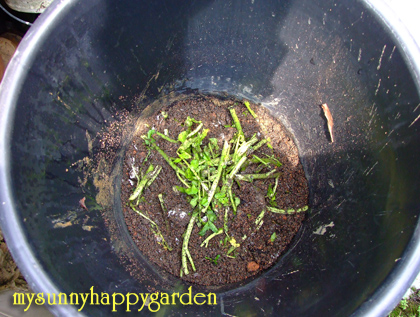To help me on making my compost, I do a lot of reading on various blogs.
I started off by using a black plastic trash can as the container for my compost. The trash can has been in my garden for awhile and not used. So it's timely to put it into good use now.
Kitchen waste went into my compost trash can.
Cover the vegie with soil. Keep the soil moist. If too much water is added, add more soil.
You don't want your compost waste to be drowning in too much of water. Then close the lid of the can. Prevent flies from rearing eggs on your compost or else you will find many maggots in it.
The finished product shall be brown in colour and crumby in texture. It will take 3-6 months to be completed. So the latest by Nov I should have a big can of compost!!
For tips, I refer to: an article posted on Gardening with Wilson: How to do Compost?
The composting method that was introduced in the second article (pls go to the link to view the article) by my colleagues working in HortPark was one that uses aerobic conditions. Aerobic composting is normally faster and produces less odour compared to anaerobic composting. Aerobic composting entails the use of a container with holes or gaps on the side that allow air to permeate into the compost heap.
Anaerobic composting, on the other hand, takes place inside a sealed container. Normally, a container is first charged with compostable waste to its brim and then shut tight to allow breakdown to take place. Fermentation then occurs and rather strong odour can be released from the container. The product that result is usually more acidic and wet to touch.
In contrast, aerobic composting usually results in a drier and more pH neutral product. But it requires ’turning’ (mixing) of the compost heap’s contents on a regular basis to introduce air into the mixture. The usage of a container with holes can be problematic because pests such as ants and other critters would be attracted and have access to the heap’s contents.
To prevent pests from being attracted to the compost heap, individuals who are high-rise apartment dwllers prefer to use a closed container to do composting at home. Their approach is like a hybrid between the two mentioned above.
My fellow members from the Green Culture Singapore discussion forum used large ceramic jars for this purpose. They covered the mouth of the jar with a lid that seals it shut. After they added fresh kitchen waste into the heap, they turned the heap to introduce air into it, which also helps to mix its contents evenly.
Because kitchen waste is generated and added to the container everyday, this turning procedure is done on a daily basis. Turning is necessary even after the container is filled to its brim to allow air to get into the heap. Depending on the ratio of green and brown waste in the heap and prevailing environmental conditions, usable compost can be ready for use in one month!
It is important to cut up the organic waste into fine bits before adding them to the heap! When cut up, they break down much easily and faster.




2 comments:
Happy composting J.C.... Lets see what happen in November.
~ bangchik
Hi JC, good idea for waste vege... make compost. Btw, yesterday I was not able to enter your blog. Today is ok :-) In your new banner, the Desert Rose is most outstanding. Good job!
Post a Comment